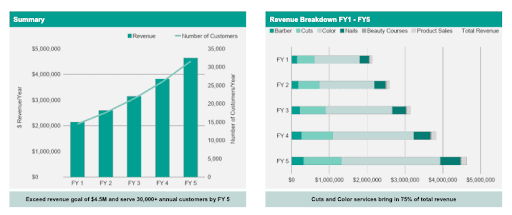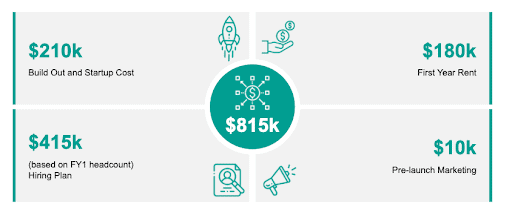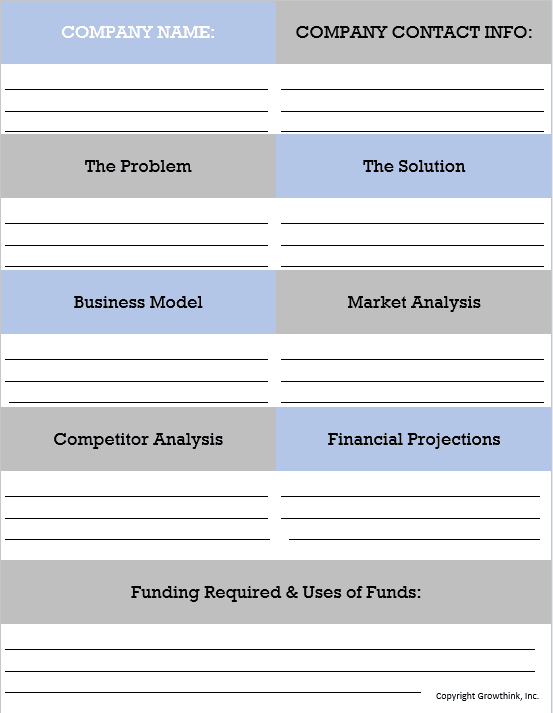The one-page business plan is one of the most popular tools for entrepreneurs, startups, and established companies. It’s also one of the simplest to develop. This article will walk you through a description of a one-page business plan, the purpose of this type of plan, and how to create a one-page business plan for your company.
What is a One-Page Business Plan?
A one-page business plan is a compressed version of a traditional business plan that fits neatly into a single page. Creating a one-page business plan requires significant research, strategizing and financial modeling on the front end to be effective. In that respect, rather than being easier or simpler to create than a full-length business plan, the single-page business plan actually requires an additional distillation effort for the entrepreneur.
As always, utilizing a business plan template provides the basis for you to clearly communicate your value proposition, business concept, business strategy, services, product offerings, etc., and improve your business planning process.
Benefits of Using a One-Page Plan
A one-page plan is easier to read, share and understand.
By boiling down your business plan into one page with only the most important elements, you are better able to 1) focus on the key action items your business must accomplish and 2) present your vision and plan to your team in a way that won’t overwhelm them and will allow them to most easily understand it.
The reward is that the brevity of a 1 page business plan is very attractive to prospective investors, who are usually pressed for time. Because it is so brief, it is also an effective tool to share among your management team and employees to get your team motivated and working towards the same goals. A strong one-page business plan proves you grasp the crux of your business and appreciate what is most critical for audiences to quickly understand about it.
Below, we walk through the content of a one-page business planning template.
The One-Page Business Plan Template
Whether you are starting a service business or a product-focused business, your one-page business plan should include the following 7 items:
- Problem
- Solution
- Business Model
- Market Analysis
- Competitor Analysis
- Financial Projections
- Funding Required & Uses of Funds
Each of these items are detailed below.
Finish Your Business Plan in 1 Day!
Don’t you wish there was a faster, easier way to finish your business plan?
With Growthink’s Ultimate Business Plan Template you can finish your plan in just 8 hours or less!
Click here to finish your business plan today.
How to Create a One-Page Business Plan
Each of the key elements included in a traditional business plan retains its position in the 1 page business plan. You need only provide a few words, phrases, or sentences in the description for each of the sections and move on to the next. The following are the essential elements:
1. Problem

For example, Netflix in its budding days identified a problem with video stores. It was time consuming and inconvenient to go to the video store every time you felt like watching a new movie.
2. Solution

Again, looking at Netflix, the company initially solved the problem of time consumption and inconvenience by delivering movies directly to customers’ homes.
3. Business Model

Consider the example of YouTube. YouTube’s business model hinges on users who by and large engage on the platform for free. YouTube leverages this ever-increasing user base to attract advertisers, which provides revenues.
4. Market Analysis

For example, Swedish furniture brand Ikea’s US target market could be described as urban young professionals who like the Scandinavian style and are willing to put in a little setup work themselves to save money on quality furnishings. These individuals spend, on average, $8,000 on furnishing when they move into a new home or apartment.
5. Competitive Analysis

Take the example of coffee giant Starbucks. Their competitor analysis would yield large brands like Dunkin’ Donuts, Panera Bread and McDonald’s McCafé, as well as boutique coffee shops on a neighborhood by neighborhood basis. Starbucks differentiates itself through providing specialty coffee products of consistent quality under a national brand.
6. Financial Plan & Projections

See below for example graphs that show a growth in topline revenues year over year as well as the projected revenue distribution by service area for a hair salon:
7. Funding Required & Uses of Funds

See below for an example table of fund uses for a startup hair salon:
Free Downloadable One-Page Business Plan Example PDF
Download our one page business plan template pdf here.
Final Thoughts
Remember to focus on your business’ strengths as much as you can. If your market analysis reveals you have a strong position then highlight it more in the single-page plan. Likewise, if your financial projections come out stronger then elongate the financial section.
Editing the enormity of a business plan into a single page is a daunting task but doing so will bring clarity to the core idea and value of your business and help you pitch well in front of potential investors.
One-Page Business Plan FAQs
What are the benefits of one-page business plans?
Traditional business plans are sometimes 25-50 pages long. It's hard to read that many pages for one company, let alone dozens of them.
One-page business plans are more digestible.
They provide key points on what you do, why you do it, and how you plan for growth.
What is the difference between a one-page business plan and a lean business plan?
A one-page business plan is a reduced version of a traditional business plan that can be easily wrapped onto a single sheet of paper.
The key elements included in a one-page business plan are:
- Problem
- Solution
- Business Model
- Market Analysis
- Competitor Analysis
- Financial Projections
- Funding Required & Uses of Funds
On the other hand, a lean business plan is a short-term planning method that allows you to more quickly and accurately develop your business plan based on actual customer feedback and interactions. A lean business plan is focused more on helping you build a better business and testing a variety of strategies to assess if they are effective for your chosen business model.
Also in a single-page format, the key elements included in this type of plan are:
- Business Overview
- Value Proposition
- Key Partnerships
- Key Activities
- Key Resources
- Customer Relationships
- Customer Segments & Channels
- Cost Structure
- Revenue Streams
A typical rule of thumb for these types of plans is that every sentence should be meaningful and useful for orientation purposes in order to appease investors in an efficient way while retaining their interest long enough to make an informed decision about investing in your business.
Looking for more information? Lean Business Plan: How-To Guide & Template
Finish Your Business Plan in 1 Day!
Don’t you wish there was a faster, easier way to finish your business plan?
With Growthink’s Ultimate Business Plan Template you can finish your plan in just 8 hours or less!
Click here to finish your business plan today.
OR, Let Us Develop Your Plan For You
Since 1999, Growthink has developed business plans for thousands of companies that have gone on to achieve tremendous success.
Click here to see how Growthink’s professional business plan consulting services can create your business plan for you.





 Create Your Business Plan Easily
Create Your Business Plan Easily How to Write a Great Business Plan
How to Write a Great Business Plan The Perfect Business Plan Outline for a Great Plan
The Perfect Business Plan Outline for a Great Plan Use This Business Plan Format to Expertly Write Your Plan
Use This Business Plan Format to Expertly Write Your Plan 100 Example Business Plans
100 Example Business Plans Finding a Business Plan Consultant
Finding a Business Plan Consultant How to Write a Business Plan Executive Summary
How to Write a Business Plan Executive Summary 10 Key Components of a Business Plan
10 Key Components of a Business Plan What is a Business Plan?
What is a Business Plan? Growthink’s Expert Business Plan Writer
Growthink’s Expert Business Plan Writer How to Write the Business Plan Management Team Section
How to Write the Business Plan Management Team Section Business Plan Software Options
Business Plan Software Options How To Write A Venture Capital Business Plan
How To Write A Venture Capital Business Plan How Long Should a Business Plan Be?
How Long Should a Business Plan Be? Growthink Reviews
Growthink Reviews